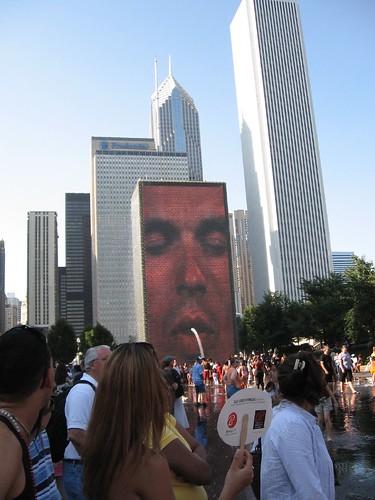
Screen grab from Perry Bard’s Man with a Movie Camera web page
The BBC has entered the public art arena in a way U.S. television stations wouldn’t dream.
They are expanding their program of bringing big screen, LED video projections beyond the usual news and tidbits of daily local life. They are adding art commissions to the mix of what gets projected.
The screens are in public spaces like downtown Manchester and Leeds.
I learned about the project from a New York artist named Perry Bard, who was at a my friend Lenore Malen’s art opening (see post). Bard had met the BBC producers at a conference in Amsterdam about using public space projections.
Bard submitted her idea to the Beeb and became one of four artists selected for the BBC’s big screens. Her project, which will be screened on several screens, the first in Manchester starting in October, is based on Dziga Vertov’s 1929 Man with a Movie Camera. She put out a call for modern retakes from around the world of the scenes described by Vertov; the archived scenes will become part of a montage screened into the public space.
Although Bard’s deadline collecting scenes for the Manchester big screen is past, submissions to her for the other three venues are still open.
What interests me about this is the rethinking of what makes public art. It doesn’t have to be a statue in the square. It also rethinks a commercial and network venture into something more contemplative, yet still accessible to a wide audience.
One of the things that I have always loved about public art was its access to a wider audience. The audience will not respond to public art that fails to entertain, that looks inward toward art issues instead of outward toward real life in the world in which we live.
A moving screen is fairly unforgiving in its ability to hold attention. It’s the slave of the quick cut, the steady action, and the impulse to tell a narrative through time.
But it is today’s medium for narrative. Our greatest talents are writing fewer books, creating more movies.

I suppose there’s something cheesy and repellent about most big screens in public spaces. (I feel that way about billboards, too). But since they are there, the idea of using them for art is really a pretty swell thing. I am thinking of the fabulous Jaume Plensa video fountain in Chicago’s Millennium Park, which creates a lovable public play space, uses morphing faces of Chicagoans who turn into spouting gargoyles, and takes advantage of digital technology.
What started me on this post was another email from Bard, who will be in
Terra Infirma, an exhibit that also deals with issues of the quotidien–and how instability that has been incorporated into society’s daily routine since 9/11. The exhibit is Sept. 27 — Nov. 30 at Pratt Manhattan Gallery.





